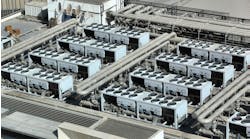After two years of virtual events, the AHR Expo made its triumphant return to in-person events with a showcase of cutting-edge HVAC technology in Las Vegas.
AHR 2022 was marked by a few themes that were echoed in ASHRAE and AHRI’s 2022 Trend Report. This industry snapshot captured the opportunities, threats and challenges facing the HVAC industry in the near future, including a major theme that the organizations dubbed “The Future is Clean.” New regulations, the push toward decarbonization and electrification, and the emergence of new refrigerants with low global warming potential (GWP) are making a significant mark on the HVAC industry.
In addition, the pandemic has encouraged a focus on clean air as well—people are more aware of their indoor environments and are clamoring for more insight into what they’re breathing.
These trends were mirrored on the show floor, where we found these three themes emerging.
[Related: Today’s Top Trends in HVAC Technology]
1. The Push Toward Low-GWP Refrigerants
Several manufacturers have introduced low-GWP refrigerants. This innovation is a response to the phasedown of hydrofluorocarbon (HFC) refrigerants, which contribute to global warming.
Daikin recently introduced the ATMOSPHERA ductless system, which uses R-32, a single-component refrigerant. R-32 is already in wide use in Europe and Asia (as well as window units in the U.S.) and makes up 50% of R-410A, one of the refrigerants targeted by the phasedown. It has a GWP of 675, compared to R-410A’s 2,088 GWP.
“[R-32 is] proven, easy, efficient and available,” explained Philip Johnston, GM and low GWP program leader for Daikin Applied. “It’s a non-proprietary component that’s manufactured by many companies around the world, so people can trust that they can get it. R-32 is the backbone of R-410A, and it’s also the backbone of other proprietary blends. It works, and it performs so well.”
Honeywell introduced Solstice N71 at AHR. This refrigerant is optimized for supermarket applications and is designed to take the place of R-404A, another HFC refrigerant that’s subject to the phasedown. It’s non-flammable, energy-efficient and has a GWP of less than 150. “N71 is going to be 13% more efficient than R-404A, and compared to a CO2 system, it’s 30% more energy efficient,” explained Sunita Rai Singh, general manager and global LOB, advanced materials and fluorine products, for Honeywell.
2. Local Moratoriums on Gas and Oil
Gas- and oil-fired furnace-type heating systems are on the way out in several cities and states that have created a moratorium on new construction with gas, explained Mike Smith, senior manager of marketing and communications for Mitsubishi Electric Trane HVAC US. One possible replacement is a high-performance heat pump. Some models can also heat domestic hot water, making them a solid solution.
Consumers seem to be happy that more sustainable solutions are on the market, but are also demanding cost savings through greater efficiency, Smith added. Mitsubishi Electric Trane HVAC US has conducted focus groups to ask customers about sustainability topics and discovered that what customers really want is a balance between these two things.
“We’re trying to help balance the sustainable benefits with the efficiency benefits of our products, so not only can customers save money and have a more efficient system, they can also be benefiting society and their community by lowering their emissions, which they want to do,” Smith said.
[Related: Is VRF the HVAC Solution for Your Hotel?]
3. The Demand for Cleaner Air
COVID-19 is driving a renewed focus on indoor air quality. People increasingly want to know what they’re breathing—and that encompasses all aspects of air quality, not just the risk of virus transmission. HVAC technology manufacturers are responding with greater IAQ transparency. One such offering in this space is Johnson Controls’ OpenBlue IAQ as a Service, which begins with a baseline understanding of how the building is operating, then addresses any indoor air quality needs as they come up.
OpenBlue IAQ as a Service is offered as a subscription, explains Tyler Smith, executive director of healthy buildings for Johnson Controls. That shifts what could have been major upfront capital investments over to the building’s operating budget. It also means daily monitoring is in place with IAQ sensors, so someone is measuring progress toward IAQ goals every day instead of putting a solution in place and forgetting about it.
enVerid, another company operating in the IAQ space, is targeting air quality with its sorbent ventilation technology, which captures VOCs, CO2 and other gaseous contaminants. The company now offers a HEPA filtration system that combines with the sorbent ventilation system to target not only gases, but also microbials, bioaerosols and particulate matter. This way, the indoor air is cleaned and it’s not necessary to introduce maximum outdoor air all the time, which is sometimes done as a precautionary measure to try to flush out SARS-CoV-2 and other airborne germs.
“That works when it’s possible, but buildings may not have the capacity to move more air through these systems, and it’s energy-intensive to condition all that outdoor air,” said Christian Weeks, CEO of enVerid. “That led to risk modeling and further analysis. How can we combine ventilation with high levels of filtration to clean the indoor air and not just rely on outdoor air to maintain safe spaces?”
Read next: This HVAC Unit is Solar-Powered



